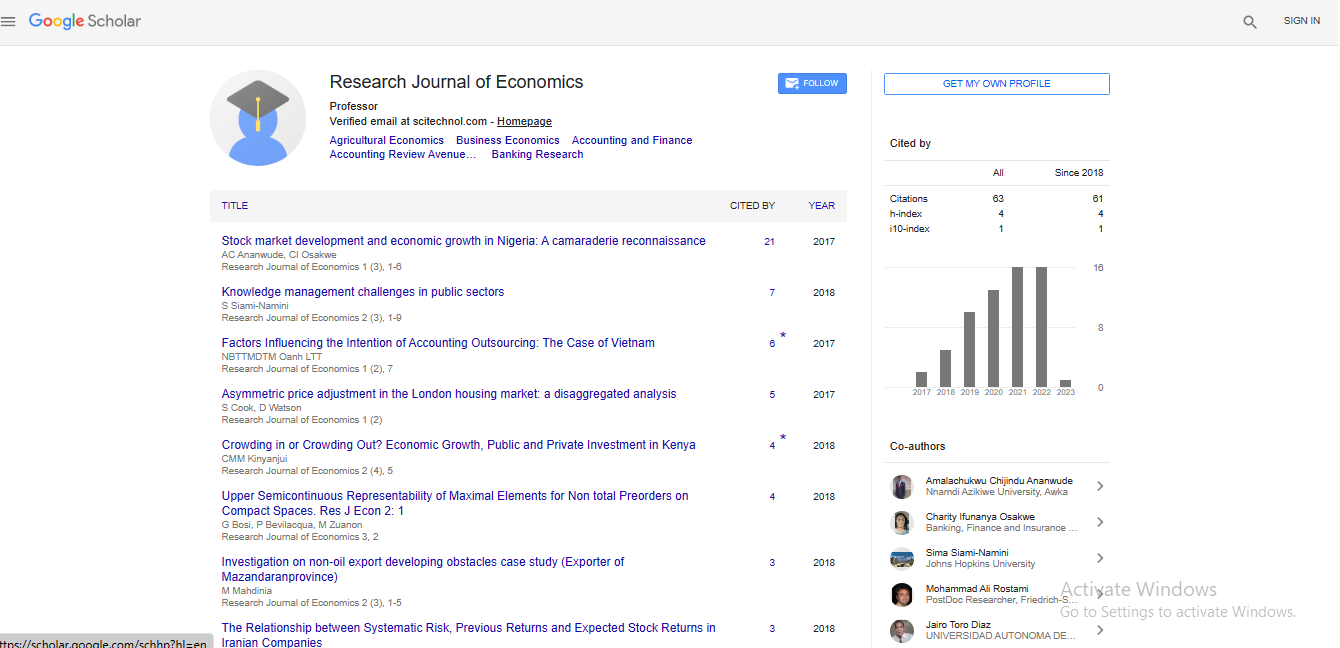Perspective, Res J Econ Vol: 8 Issue: 1
The Issue of Inflation in Economic Growth
Hiaghiai Huwang*
Department of Economics, Wilfrid Laurier University, Waterloo, Canada
- *Corresponding Author:
- Hiaghiai Huwang
Department of Economics,
Wilfrid Laurier University,
Waterloo,
Canada;
E-mail: hiaghiai_huwang@gmail.com
Received date: 04 November, 2023, Manuscript No. RJE-23-119242;
Editor assigned date: 06 November, 2023, PreQC No. RJE-23-119242 (PQ);
Reviewed date: 20 November, 2023, QC No. RJE-23-119242;
Revised date: 15 July, 2024, Manuscript No. RJE-23-119242 (R);
Published date: 22 July, 2024, DOI: 10.4172/RJE.1000180
Citation: Huwang H (2024) The Issue of Inflation in Economic Growth. Res J Econ 8:1.
Introduction
Demand for commodities often exceeds supply during the stage of an economic cycle, allowing companies to boost their prices. As a result, the inflation rate rises. Inflation is defined as a prolonged increase in overall price levels. Inflation that is moderate is related with economic growth, but excessive inflation might indicate an overheated economy. When economic growth rises, demand accelerates even faster, and manufacturers continue to boost prices. Price increases can also be caused by supply restrictions in the absence of a significant shift in demand. A price spiral, often known as "runaway inflation" or "hyperinflation," can occur. In the United States, the inflation syndrome is sometimes defined as "too many dollars chasing too few goods," which means that when spending outpaces production of goods and services, the quantity of dollars in an economy exceeds the amount required for financial transactions. As a result, the purchasing power of a dollar falls.
Description
When the inflation rate is high; sustainable growth, equitable income distribution, projected returns on investment projects, the country's competitiveness in global commerce, the distribution of tax responsibilities, and so on. The impact of high inflation on macroeconomic variables is often discussed in the literature under the title ‘Inflation-growth relationship’. The global financial crisis of 2007-2008 led to financial stability being established as an objective of macroeconomic policy. This led to a re-evaluation of the relationship of inflation to growth in academic literature. The relationship is discussed in a non-linear way by calculating the threshold value which indicates the point at which inflation started to have a negative impact on economic growth. For example, if inflation is defined as being in the single-digit. The relationship of inflation to economic growth is uncertain and cannot be predicted with certainty. On the contrary, when the adverse effect of inflation is assessed in developing countries the threshold value of inflation is higher than it is in developed countries. Inflation and growth have been a matter of debate since the 1950’s in Latin America. Structuralisms argue that inflation is necessary for economic development, while monetarists argue that inflation impedes economic growth.
The relationship of inflation with economic growth is one of the central questions of macroeconomics. Inflation expectations are beliefs about future price increases that a household or firm has. These beliefs can influence current economic decisions that affect actual inflation outcomes. Theoretical models of inflation and growth focus on the effects on the steady state balance of capital per capita (SPS) and output. There are three possible outcomes: No impact on output and growth a positive impact on growth a negative impact on growth the first result is based on money as a substitute to capital. In an optimal control framework, M/P in the utility function is considered. The first result shows that money is neutral. The negative impact on growth (Anti-Tobin effect) is mainly related to cash in advance models. For instance, if companies anticipate higher inflation in the future and act on those expectations, they may increase the cost of their products and services faster. Similarly, workers who anticipate higher inflation may ask for higher wages to compensate for the expected loss in purchasing power. Inflation psychology, sometimes referred to as ‘inflationary psychology’, helps to increase the rate of real inflation so that inflationary expectations become self-reinforcing.
Conclusion
Because inflation expectations can affect real price and wage formation, the degree to which inflation expectations ‘anchor’ also affects future inflation performance. For instance, if household’s and firm’s expectations are that inflation will return to the central bank’s inflation target at some future point, regardless of current inflation, describe those expectations as ‘anchored to the inflation target’. When inflation expectations are anchored, higher inflation–for example, due to a ‘cost‑push event’–will not cause changes in the behaviour of households and firms, and inflation is likely to return to the target over time.
 Spanish
Spanish  Chinese
Chinese  Russian
Russian  German
German  French
French  Japanese
Japanese  Portuguese
Portuguese  Hindi
Hindi 